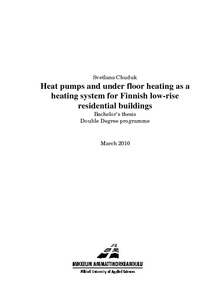Thermodynamic examination and heat integration of Lyocell process using Pinch analysis
Ekosaari, Eemeli (2024)
Ekosaari, Eemeli
2024
All rights reserved. This publication is copyrighted. You may download, display and print it for Your own personal use. Commercial use is prohibited.
Julkaisun pysyvä osoite on
https://urn.fi/URN:NBN:fi:amk-2024052716240
https://urn.fi/URN:NBN:fi:amk-2024052716240
Tiivistelmä
Opinnäytetyön toimeksiantaja Metsä Spring Oy sijoittaa kehityshankkeisiin ja potentiaalisiin innovaatioihin, joilla pohjoismaisen puun jalostusarvoa on mahdollista kasvattaa. Yksi Metsä Springin hankkeista on puu-pohjainen, paperisellusta valmistettava Kuura-tekstiilikuitu, minkä ensimmäistä kaupallista tuotantolaitosta koskeva esiselvitys oli käynnissä työn julkaisuhetkellä. Yksi mahdollisista kaupallisista teknologioista tekstiilikuidun valmistukseen on liukosellua käyttävä lyocell-prosessi. Opinnäytetyön tehtävänä oli analysoida hypoteettisen lyocell-prosessin energiankäyttöä pinch-analyysimenetelmän avulla ja tavoitteena oli optimoida prosessin sisäinen lämmönsiirto. Työn tietoperusta muodostettiin aiheeseen liittyvistä käsitteistä ja lainalaisuuksista, mitkä tukevat työn tutkimuksellista osuutta. Analyysia varten lyocell-prosessin lämmitys- ja jäähdytystarpeet koostettiin jo aiemmin kehitetystä simulointimallista, mitä on käytetty prosessin teknistaloudelliseen tarkasteluun. Lähtötiedoista muodostettiin analyysityökalua hyödyntäen summakäyrät, joiden avulla prosessin energiankäyttöä voitiin tarkastella graafisesti. Analyysista saatujen tietojen avulla tutkittiin mahdollisuuksia erilaisille prosessimuutoksille ja lämmönvaihtimien kytkennöille. Opinnäytetyön tuloksena saatiin tarkastelu lyocell-prosessin lämmitys- ja jäähdytystarpeista erilaisten toimenpiteiden jälkeen verrattuna alkuperäiseen prosessiin. Ehdotetut prosessimuutokset liittyivät haihdutuksen energiankäytön tehostamiseen, lämpöpumppujen hyödyntämiseen sekä lämmönvaihdinverkkoon. Tarkastelussa huomioitiin myös tarvittavien ulkoisten käyttöhyödykkeiden kustannukset. Työstä saatuja tuloksia on mahdollista käyttää toimeksiantajan esiselvityksen tukena, etenkin Kuura-tekstiilikuidun kaupallisen tuotantolaitoksen prosessisuunnittelussa. Opinnäytetyötä on mahdollista kehittää laajentamalla tutkimuksen kohteena olevaa prosessikokonaisuutta. Lyocell-prosessissa tarvittavia käyttöhyödykkeitä tuottavan laitoksen tutkiminen pinch-analyysimenetelmän avulla voisi antaa paremmat lämmitys- ja jäähdytystarpeiden integrointimahdollisuudet. The assignor company of the thesis, Metsä Spring Oy, invests in development projects and potential innovations with the goal of increasing the value creation from Nordic wood. One of the projects of Metsä Spring is the paper-pulp -based Kuura textile fiber production. A pre-study related to a possible first commercial Kuura production plant was ongoing at the time of publication of the thesis. One of the possible commercially available technologies for producing textile fibers is Lyocell process using dissolving pulp. The task of the thesis was to investigate the energy use of a hypothetical Lyocell process using the Pinch analysis method and the goal was to optimize the internal heat exchange of the process. The theoretical framework for the thesis was formed from concepts and principles related to the topics supporting the goal. The heating and cooling demands of the Lyocell process were compiled for the Pinch analysis from a simulation model, which had been previously developed and used for the purpose of enabling a techno-economic analysis of the process. Composite curves were created from the stream data using an analysis software. It enables examining the energy consumption of the process graphically. The possibilities for various process changes and heat exchanger connections were investigated using the information obtained from the analysis. The result of the thesis was an examination of the heating and cooling demands of the Lyocell process before and after the various changes were done to the original process. The proposed process changes were related to increasing the energy efficiency of evaporation, the utilization of heat pumping and the heat exchanger network. The examination also considered the operating expenses of required external utilities. The learnings of the thesis can be used to support the assignor company’s pre-study, especially in process design of the commercial Kuura textile fiber production plant. There are also possibilities to develop the topic of the thesis by expanding the scope of the research. Examining the plant that produces the required external utilities for the Lyocell process with the Pinch analysis method could provide better opportunities to integrate the heating and cooling demands.
Kokoelmat
Samankaltainen aineisto
Näytetään aineisto, joilla on samankaltaisia nimekkeitä, tekijöitä tai asiasanoja.
-
Heat pumps and under floor heating as a heating system for Finnish low-rise residential buildings
Chuduk, Svetlana (Mikkelin ammattikorkeakoulu, 2010)In bachelor’s thesis the study of under floor heating system with ground source heat pump for the heat transfers fluid heating is considered. The case study is low-rise residential building in Finland with under floor ... -
Arrangement for recovering and utilizing the waste heat generated onboard a ship in district heating
Vuorinen, Otto (2021)The objective of the present Master’s thesis was to study the feasibility of an idea behind a Finnish patent to utilize the waste heat generated onboard a ship by it’s engines and to use it in an onshore application to ... -
District Heating Rehabilitation in Russia : The hydro-ejector system's replacement with the plate heat exchanger
Vuorensola, Jussi (Oulun ammattikorkeakoulu, 2015)This thesis has two assigners. The first one is Karelia institute, which wanted more information about the hydro-ejector's functions and Russian heating norms. Besides of that Jupra Oy, which wanted to find out about ...



